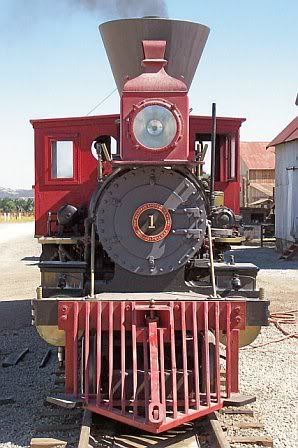By Ed Kelley
 Despite her 1860s appearance, No. 1 holds the distinction of being the newest locomotive on the Pacific Coast roster. A 5/8-scale replica inspired by the famed Civil War-era locomotive “The General,” No. 1 was one of two such engines built for the Astroworld theme park of Houston, Texas. Three parties played a role in their construction; the running gear and tenders were completed by Guiberson-Harpur of Wilmington, California, while the boilers were built at Superior Boiler Works of Kansas. Final assembly was completed in Texas by J.K. Byrne in 1968.
Despite her 1860s appearance, No. 1 holds the distinction of being the newest locomotive on the Pacific Coast roster. A 5/8-scale replica inspired by the famed Civil War-era locomotive “The General,” No. 1 was one of two such engines built for the Astroworld theme park of Houston, Texas. Three parties played a role in their construction; the running gear and tenders were completed by Guiberson-Harpur of Wilmington, California, while the boilers were built at Superior Boiler Works of Kansas. Final assembly was completed in Texas by J.K. Byrne in 1968.As the railroad encompassed the park - much like the 610 Freeway encircles the City of Houston - Astroworld’s loopline was christened the “610 Limited.” The locomotives, numbered 1 and 2, bore the names “Cannonball” and “Spitfire,” respectively, and together comprised the only motive power for the park’s first decade-and-a-half of existence.

No. 1 "Cannonball" at Astroworld,
c.1978. Courtesy Tod Peddie
The slow demise of Astroworld’s little steam railroad began in the early 1980s, when Six Flags - who acquired the park in 1975 - was unwilling to fund necessary boiler repairs for the No. 2 and sold it for scrap price. Sold to Gary Norton, it saw a brief return to service on the Silverwood Central Railroad of Athol, Idaho, until displaced by larger motive power. It has since passed through private hands in Durango, Colorado, and is currently under restoration in Georgetown, CA. Adding to the loss of No. 2, steam operations took another blow when a diesel electric and diesel hydraulic locomotive were transferred from Six Flags Magic Mountain. Employees’ pleas and persistence were all which kept steam in operation for the remainder of Astroworld’s existence. When Six Flags announced plans to close the financially-troubled park and auction its assets, the locomotive was operating just one weekend each month.

The crew that kept her running
in 1978. Courtesy Tod Peddie
In January, 2006, on behalf of Rob Rossi, Phil and Karell Reader negotiated the purchase of No. 1 prior to the auctioning of the park’s remains. Since her arrival at the ranch, she has been a continuous project, and will eventually receive significant cosmetic improvements including a new cab, stack, and paint scheme. All will be done true to her classic 1860s lines, keeping her a regularly-operating representation of the locomotives which won the West. With the dieselization of the two Harpur locomotives at Six Flags Over Georgia, No. 1 has the distinction of being the only operable Harpur locomotive in the world. She was placed into service on the Pacific Coast in April, 2006.










